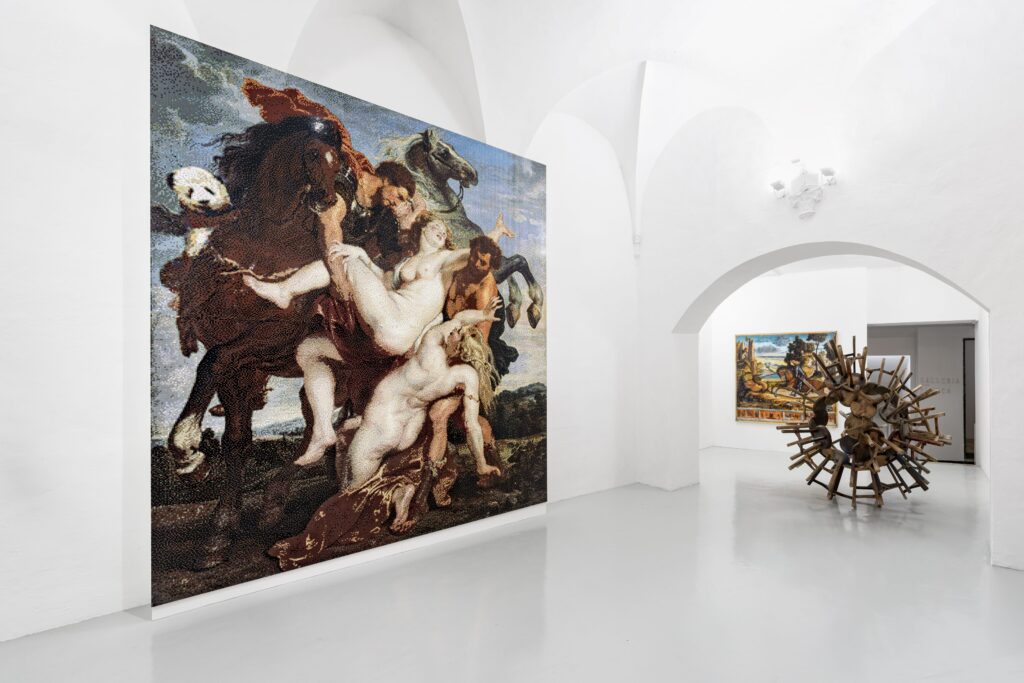An emblematic figure in the contemporary art landscape, Ai Weiwei is known not only for his creativity and artistry but also for his courage in raising relevant political and social issues through his art and his public voice.
The artist was born in Beijing, China, on August 28, 1957. He is the son of the famous Chinese poet Ai Qing, who was persecuted by the Chinese communist government and exiled and later acclaimed as a great national poet after the death of Mao Zedong in 1976.
Ai studied at the Beijing Film Academy before moving to New York in the 1980s to pursue his interests at Parsons School of Design.
His artistic versatility ranges from sculpture to installation, architecture to photography and cinema. His works, often provocative and conceptual, mix tradition and modernity in a visually strong and emotional mix.
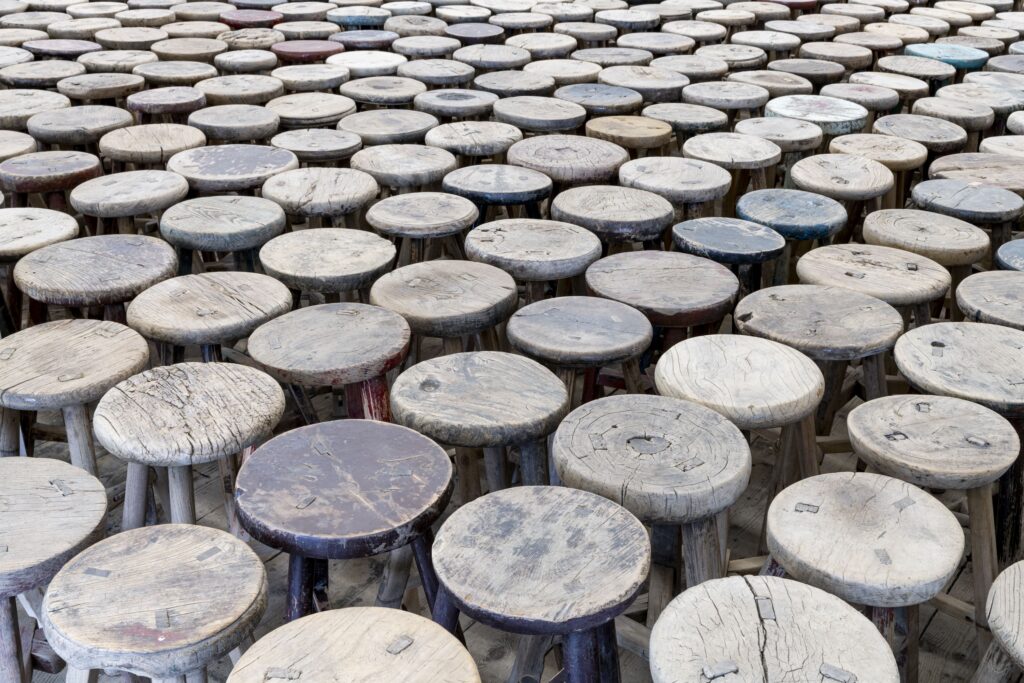
Famous are his installations such as “Sunflower Seeds”, composed of millions of hand-painted porcelain seeds that refer to the millions of Chinese in the world and the nourishment that comes from this seed, and “Forever Bicycles”, a sculpture of thousands of overlapping bicycles, but also Law of the Journey, the long black dinghy exhibited at the National Gallery in Prague and presented at the Sydney Biennial in 2018, or the large snake made up of the backpacks of the Chinese students who died in the Sichuan earthquake (360 backpacks sewn together, in Munich, the same installation on the façade of the Kunsthaus saw 9,000), to reflect on the importance of prevention and legality and more. All works of denunciation are aimed at making the viewer reflect like a slap useful to bring you back to reason.
Therefore, Ai Weiwei works actively with a strong political and social commitment, through his art, he openly criticises the Chinese government for censorship and the lack of human rights, suffering arrests and passport confiscations. In the past he has used social media and digital documentation to spread his message beyond physical borders, making his blog a platform for public debate and online activism.
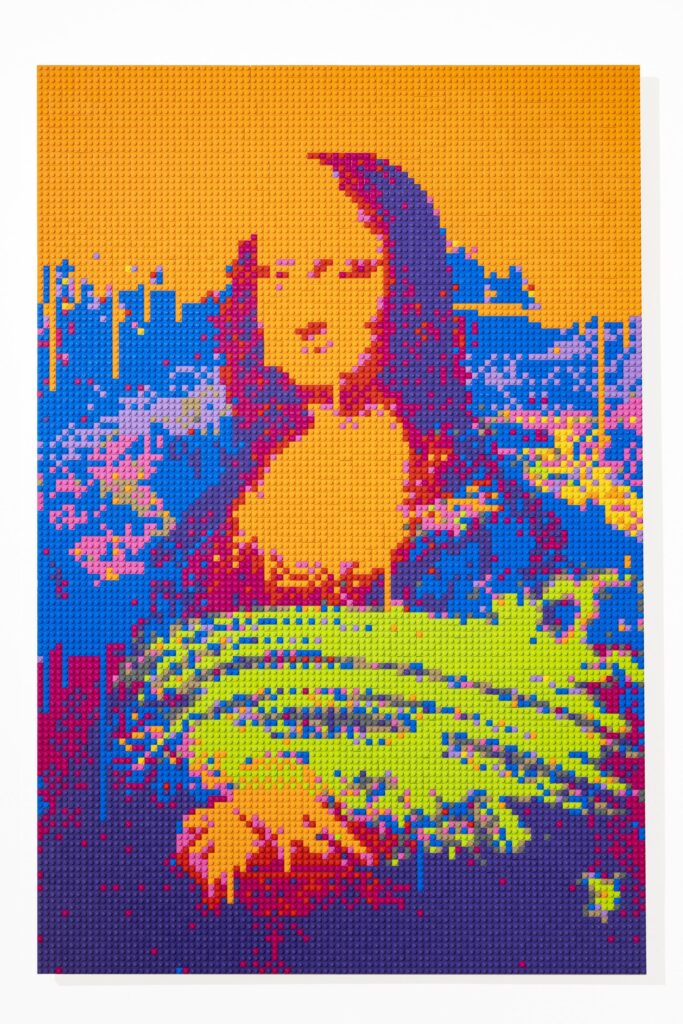
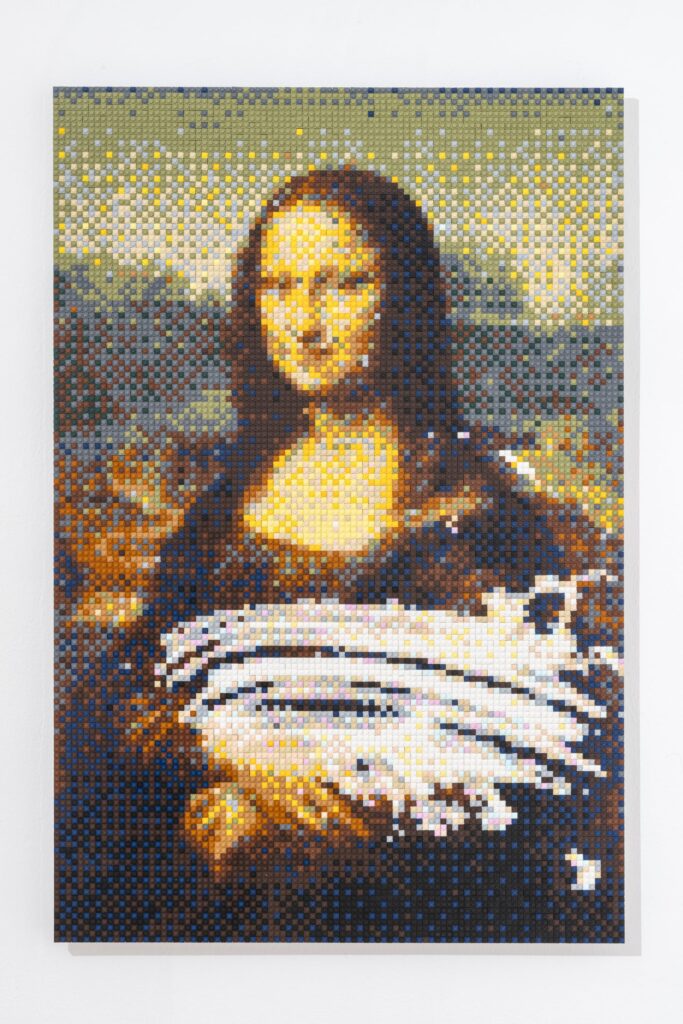
On the right: Ai Weiwei, Mona Lisa Smeared in Cream, 2023, toy bricks (LEGO)114 x 76 cm, 44.88 x 29.92 in. Courtesy AI WEIWEI STUDIO and GALLERIA CONTINUA, Photo Ela Bialkowska, OKNO Studio
In this regard, the artist claims to have only a vague idea of what the Internet was when he started blogging in 2005. The artist, at the time, had collaborated on the design of the Beijing Olympic stadium and had been invited to participate in a series of celebrity blogs hosted by sina.com, the continent’s largest web portal. He quickly became obsessed with the possibilities of social media, blogging for hours every day. Over the next three and a half years he wrote more than two thousand seven hundred posts on everything, but one topic dominated Ai’s digital writings: the social, political, and spiritual turmoil that accompanied China’s economic growth. Chinese authorities shut down Ai’s blog in June 2009. Now, about a hundred of his writings have been translated and collected into an essential book, Ai Weiwei’s Blog.
Ai Weiwei is constantly vigilant because he perceives threats to freedom of expression and human rights, he monitors the intimidation tactics of the Chinese government, the restrictions on journalists and political activists, such as the protests that took place in Hong Kong or the severe limitations in Wuhan imposed during the pandemic of coronavirus and even his detention in 2011.
Ai is lucid in considering the current situation of global refugees as one of the most serious humanitarian crises since the Second World War, and sees it as a great test for societies of solidarity, underlining that each of us has a moral obligation to take meaningful and he claims:
“Time is the essence of human life and our awareness of the past, present and future is what allows us to construct our narrative. It is this possibility that shapes our understanding of value and defines our sense of self.” Ai Weiwei.
One of Ai Weiwei’s many famous works is also “Dropping a Han Dynasty Urn” from 1995, present in the exhibition, through three gelatin silver prints, 148 x 121 cm each, and incorporating what the artist defined as “cultural ready-made”.
The work depicts Ai deliberately dropping a 2,000-year-old ceremonial urn, allowing it to shatter on the floor at his feet. This object not only possessed significant monetary value but also profound symbolic and cultural value. The Han Dynasty (206 BC-220 AD) is considered a crucial phase in the history of Chinese civilization, and to knowingly destroy an iconic relic from that period is to discard an entire legacy of cultural significance for China. Through this work, Ai Weiwei began to exploit existing ancient objects, highlighting his critical approach to how cultural values are created and interpreted. The artist said that he destroyed several urns before obtaining the desired shot, precisely according to the principle that Mao wanted to destroy the si jiu (four old men): old customs, habits, culture and ideas.
The journey inside the Gallery unfolds through the presentation of a career spanning over thirty years. The first works they welcome are two large reproductions made entirely with the pixelation technique, using the well-known coloured toy bricks of the tapestries, but in plastic.
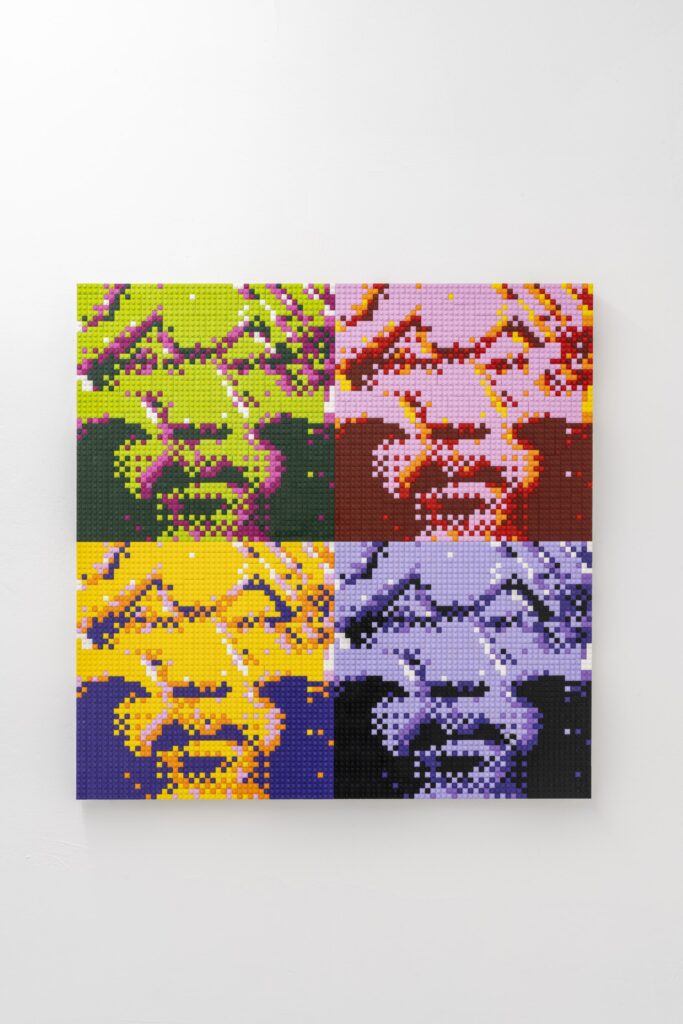
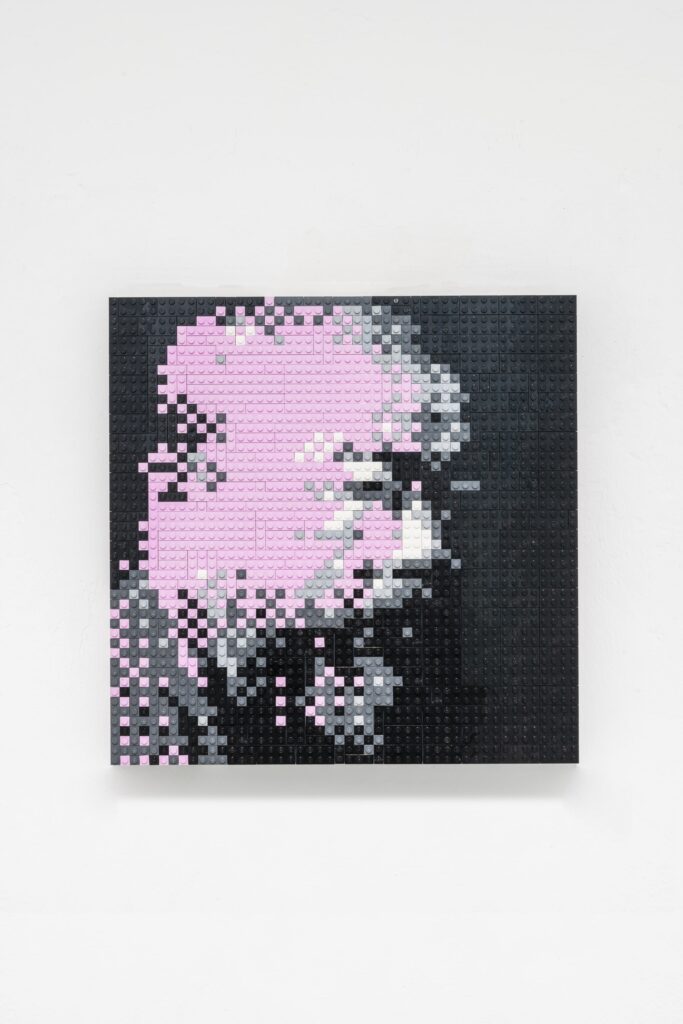
On the left, Ai Weiwei, Ai Weiwei Quadruplex, 2023, toy bricks (LEGO), 76 x 76 cm, 29.92 x29.92 in, Courtesy AI WEIWEI STUDIO and GALLERIA CONTINUA, Photo Ela Bialkowska, OKNO Studio
To the right of the main entrance, there is “Sleeping Venus with coat hanger”, a faithful reproduction by Giorgione, in which a hanger was inserted inside the work near the body of Venus, in memory of the brutal self-induced abortions, before that abortion became legal. On the opposite wall, there is another large work, this time taken from Rubens “The Rape of the Daughters of Leucippus in Untitled (After Rubens)”, here too the vigour of the bodies reveals another element inserted by the artist at the top left, a panda, symbol of contemporary Chinese state power.
On the walls of the rooms, the Lego reproductions of the most famous works in the history of art continue with intrusive elements, such as the artist himself, who takes on the role of Judas, in a large “Last Supper” taken from Leonardo Da Vinci.
The Chinese artist, architect, curator and activist Ai Weiwei often works with mass accumulations of individual objects that he accumulates in his various studios. The historical and cultural significance of the materials used by Ai is an essential element of almost all of his sculptures.
Grapes is a characteristic work by Ai Weiwei consisting of 26 stools from the Qing Dynasty (1644-1911). The common three-legged wooden stool is an old-fashioned household item in today’s Chinese society. Every home had classically made wooden stools that were passed down for generations but were replaced by plastic and aluminium variants as China modernized. Since 1997, Ai has been collecting these unique, handcrafted wooden stools and creating a variety of sculptures and installations with them.
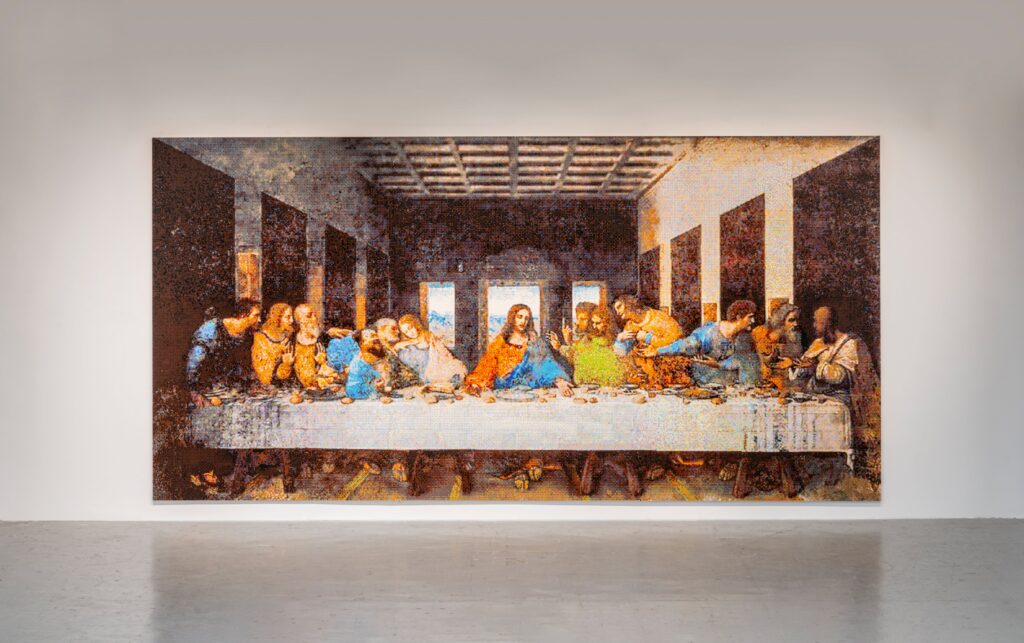
The grape serves as a metaphor for China’s socialist history, which requires the individual to put aside his or her personal interests in favour of those of the larger group or state. This sculptural accumulation of ancient stools focuses attention on issues related to the export of cultural values and historical knowledge, the clash between old and new ideas in China, and international art and antiques markets. An expanse of these can be admired in the stalls. The “Stools” installation was created with three thousand stools from the Ming and Qing dynasties up to the Republican era, covering the entire surface of the room.
We met the artist, in the spaces of Galleria Continua in San Gimignano, Italy, on the occasion of the third exhibition, entitled Neither Nor, organized by the Gallery and followed by Margherita Tinagli, one of Continua’s art historians. The meeting was moderated by Tim Marlow, Director and Chief Executive of the Design Museum of London, who touched on various points of the artist’s career, with whom Marlow has a deep friendship, and they chatted about the exhibition. From the artist’s health conditions to the exiled father who gave the artist, a very broad cultural heritage, because as Ai Weiwei claims, poetry is pure and how life can manage to take us away from rationality and logic, a bit like the game.
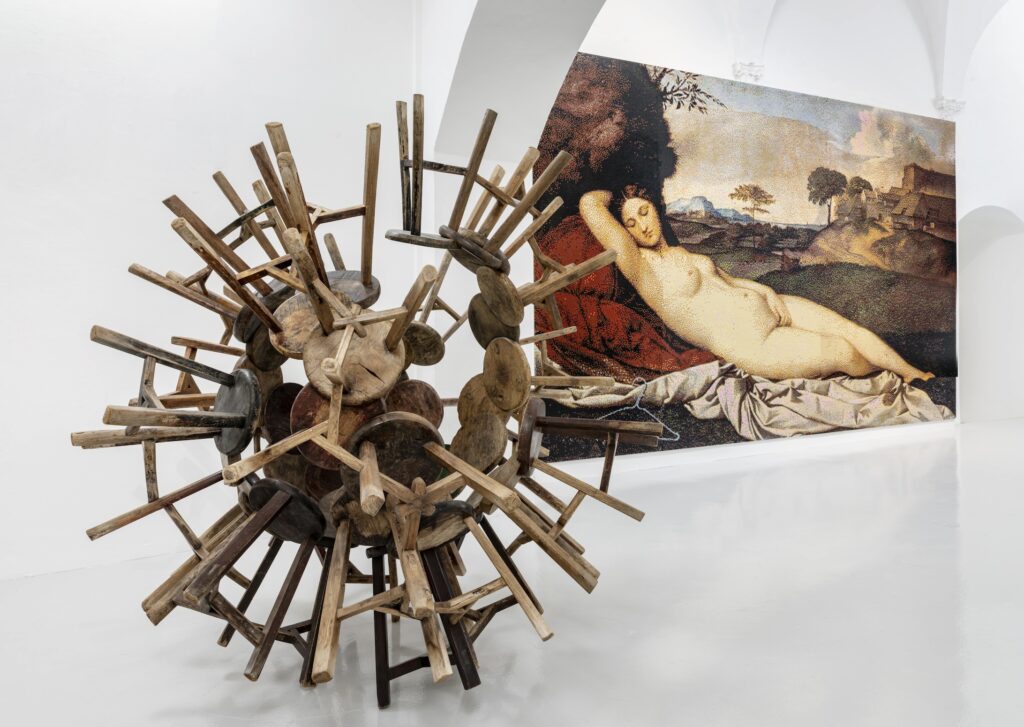
The dialogue touched on the symbolism of the elements inserted within the works, the fact of not always being understood by the public and for this reason Ai Weiwei sometimes said he felt surprised, at his collecting and the studies he has, invaded by these objects. Then he says that He doesn’t feel in competition with anyone because he knows, he is a true artist, who fights for rights with his art” and that he admires the political figure of the Pope, as he supports the faith of many, remains humble and he is one of the few, perhaps the only true political figure. An oxymoron supports the artist, because usually like the work he has behind him when he speaks, The Last Supper by Leonardo, reinterpreted, “just like Judas, many are willing to sell you, I too have placed myself there, to tell you to be careful, be wary, the Pope is not like that. He is faithful to his mission, a man of charity. Finally, the conversation reached more philosophical heights, talking about being here and now, that the future is now, and that we need to live in the moment. So, dear readers, enjoy the moment!
